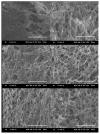Polysaccharide-Based Drug Delivery Systems for the Treatment of Periodontitis
- PMID: 34066568
- PMCID: PMC8125343
- DOI: 10.3390/molecules26092735
Polysaccharide-Based Drug Delivery Systems for the Treatment of Periodontitis
Abstract
Periodontal diseases are worldwide health problems that negatively affect the lifestyle of many people. The long-term effect of the classical treatments, including the mechanical removal of bacterial plaque, is not effective enough, causing the scientific world to find other alternatives. Polymer-drug systems, which have different forms of presentation, chosen depending on the nature of the disease, the mode of administration, the type of polymer used, etc., have become very promising. Hydrogels, for example (in the form of films, micro-/nanoparticles, implants, inserts, etc.), contain the drug included, encapsulated, or adsorbed on the surface. Biologically active compounds can also be associated directly with the polymer chains by covalent or ionic binding (polymer-drug conjugates). Not just any polymer can be used as a support for drug combination due to the constraints imposed by the fact that the system works inside the body. Biopolymers, especially polysaccharides and their derivatives and to a lesser extent proteins, are preferred for this purpose. This paper aims to review in detail the biopolymer-drug systems that have emerged in the last decade as alternatives to the classical treatment of periodontal disease.
Keywords: antibacterial properties; drug delivery systems; electrospun fibers; films; gels; hydrogels; microparticles; nanoparticles; periodontitis; polysaccharides.
Conflict of interest statement
The authors declare no conflict of interest.
Figures




Similar articles
-
The current advancements in chitosan nanoparticles in the management of non-surgical periodontitis treatment.Nanotoxicology. 2025 May;19(3):290-324. doi: 10.1080/17435390.2025.2484002. Epub 2025 Mar 28. Nanotoxicology. 2025. PMID: 40151940 Review.
-
Recent development of chitosan-based polyelectrolyte complexes with natural polysaccharides for drug delivery.Int J Biol Macromol. 2014 Mar;64:353-67. doi: 10.1016/j.ijbiomac.2013.12.017. Epub 2013 Dec 17. Int J Biol Macromol. 2014. PMID: 24360899 Review.
-
Hydrogel design and applications for periodontitis therapy: A review.Int J Biol Macromol. 2025 Jan;284(Pt 1):137893. doi: 10.1016/j.ijbiomac.2024.137893. Epub 2024 Nov 19. Int J Biol Macromol. 2025. PMID: 39571840 Review.
-
A dual-action chitosan-based nanogel system of triclosan and flurbiprofen for localised treatment of periodontitis.Int J Pharm. 2019 Oct 30;570:118659. doi: 10.1016/j.ijpharm.2019.118659. Epub 2019 Sep 4. Int J Pharm. 2019. PMID: 31493495
-
Evaluation of cross-linked chitosan microparticles containing metronidazole for periodontitis treatment.Mater Sci Eng C Mater Biol Appl. 2013 Apr 1;33(3):1197-202. doi: 10.1016/j.msec.2012.12.010. Epub 2012 Dec 8. Mater Sci Eng C Mater Biol Appl. 2013. PMID: 23827560
Cited by
-
Polymeric Gel Systems Cytotoxicity and Drug Release as Key Features for their Effective Application in Various Fields of Addressed Pharmaceuticals Delivery.Pharmaceutics. 2023 Mar 3;15(3):830. doi: 10.3390/pharmaceutics15030830. Pharmaceutics. 2023. PMID: 36986691 Free PMC article. Review.
-
Biomimetic Hydroxyapatite Crystals Growth on Phosphorylated Chitosan Films by In Vitro Mineralization Used as Dental Substitute Materials.Polymers (Basel). 2023 May 26;15(11):2470. doi: 10.3390/polym15112470. Polymers (Basel). 2023. PMID: 37299269 Free PMC article.
-
The applications of polysaccharides in dentistry.Front Bioeng Biotechnol. 2022 Jul 22;10:970041. doi: 10.3389/fbioe.2022.970041. eCollection 2022. Front Bioeng Biotechnol. 2022. PMID: 35935501 Free PMC article. Review.
-
Future Drug Targets in Periodontal Personalised Medicine-A Narrative Review.J Pers Med. 2022 Feb 28;12(3):371. doi: 10.3390/jpm12030371. J Pers Med. 2022. PMID: 35330371 Free PMC article. Review.
-
In Vitro and In Vivo Characterisation of a Mucoadhesive Buccal Film Loaded with Doxycycline Hyclate for Topical Application in Periodontitis.Pharmaceutics. 2023 Feb 8;15(2):580. doi: 10.3390/pharmaceutics15020580. Pharmaceutics. 2023. PMID: 36839899 Free PMC article.
References
-
- DeRossi D. Polymer Gels. Plenum Press; New York, NY, USA: 1991.
-
- Dunn R.L., Ottenbrite R.M. Polymeric Drugs and Drug Delivery Systems. American Chemical Society; Washington, DC, USA: 1991.
Publication types
MeSH terms
Substances
LinkOut - more resources
Full Text Sources

